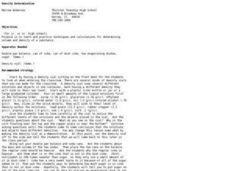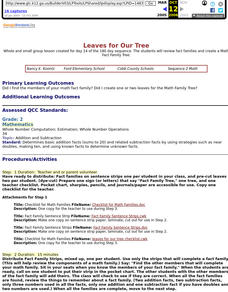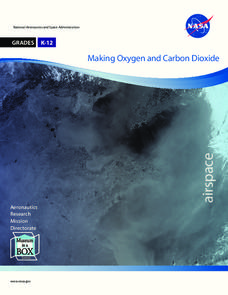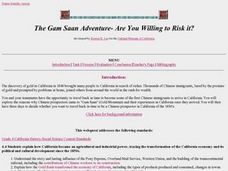Curated OER
As the Kids Come and Go: Mapping a Classroom
Map the classroom with your kids to help them understand how maps work and how to read them. The lesson starts off with a story about animals living and moving around the globe, and then kids create maps of their classroom to show how...
Curated OER
Density Determination
Young scholars observe 2 demonstrations of density. In this density lesson plan, students observe a vial with various substances of different densities. Young scholars then observe the differences between a diet coke and a regular coke...
Curated OER
Double Exposure Lesson: Discussions And Experiments About Photography
Young scholars explore photography. They compare/contrast the work of two photographers, create a paper viewfinder and experiment with focusing on topics, take photographs, and display photograph essays about the school.
Curated OER
Leaves for Our Tree
Young mathematicians review fact families and create a Math Fact Family Tree. This clever lesson plan includes some excellent printouts that support the activity.
Curated OER
First Day of GT
Pupils listen to and discuss a poem about a gifted student. They discuss what being gifted means to them and their families, and participate in a game that helps students to bond with each other.
Consortium for Ocean Science Exploration and Engagement (COSEE)
Ocean Acidification: Whats and Hows
Open this lesson by demonstrating the production of acidic carbon dioxide gas by activated yeast. Emerging ecologists then experiment with seashells to discover the effect of ocean acidification on shelled marine organisms. They measure...
University of Colorado
Phases of Charon
Pluto, although no longer considered a planet, has five moons. Pluto's moon, Charon, is the focus of a resource that describes how the moon is viewed from the surface of Pluto. Photos help individuals see how Charon would look at...
Curated OER
Survey of the Louisiana Purchase in 1815
Students explore the survey of the Louisiana Purchase by creating their own surveying and mapping techniques such as natural maps, pace maps, and orienting. Other students then try to follow the maps.
NASA
Making Oxygen and Carbon Dioxide
Some like it hot! Scholars observe both exothermic and endothermic reactions as part of the carbon dioxide oxygen cycle. First, scientists demonstrate (or watch) a chemical reaction to create pure oxygen using fire for...
Curated OER
#17 Determining the Accuracy of Selected Laboratory Glassware
Students calculate the volume of a specific mass of water placed in selected pieces of common laboratory glassware, using the density formula. They then determine the accuracy of the volumetric measurement for selected pieces of...
Curated OER
First Day of GT
Students discuss feelings about being teased about being a gifted student. In this feelings lesson plan, students then toss balls to each other and give responses based on questions asked.
Curated OER
Balancing Act
Students investigate the dramatic increase in world population and the unequal distribution of resources. They examine the six world regions and how they are affected by the increase in population.
Curated OER
Should America Balance the Federal Budget?
Students analyze the federal budget of the United States. In this national debt lesson, students listen to their instructor present a lecture regarding the details of the balancing the federal budget. Students respond to discussion...
Curated OER
DNA Coloring - Transcription and Translation
In this DNA worksheet, pupils review the transcription and translation processes. Students label and color the different parts of a DNA strand. This worksheet has 7 fill in the blank questions.
Curated OER
The Great Pond Safari
Students study pond life by visiting a pond and completing an associated worksheet. They play an online game based on the pond learning experience.
University of Colorado
Phases of Charon
Charon, the largest of Pluto's moons, was discovered in 1978. Lesson is a walk through of how to solve for the phases of Charon. It uses two different points on Pluto and takes into account the tilt of the pole, the rotational axis, and...
Curated OER
Wasting Energy at Home?
Students identify ways that energy is wasted. They develop ideas on how to conserve energy in the home. They also categorize appliances found in the home as heavy, moderate, or light users of energy
Curated OER
Eminent Domain: Whose Land is it Anyway?
Students research eminent domain and whether or not there has been a land dispute in their community. Students search local newspapers, local history books or talk with civic leaders and long-time citizens and create a chart showing the...
Concordia University Chicago
Liberty Enlightening the World by Frédéric Auguste Bartholdi
Here is a lesson that uses the painting Liberty Enlightening the World to start a discussion on the importance of national monuments. The class discusses several monuments around the world, and then invites a veteran to share his/her...
Curated OER
What's Outside the Cell Membrane ?
Students examine the cell coats (matrix) of chondrocytes and fibroblasts and observe these cells actively exclude particles which are released around them. They observe the function of the cell membrane as a gatekeeper as it prevents...
Curated OER
Weather With a Latitude
Students read the temperature from a thermometer. For this weather lesson, students read a thermometer and record the temperature at twenty minute intervals. Students discuss results.
Curated OER
The Cream of the Crop
Students read and discuss article, "Simple Method Found to Vastly Increase Crop Yields," then research the basic components of conventional and organic agricultural methods. They, in groups, organize and present their research to the class.
Curated OER
THE GAM SAAN ADVENTURE ARE YOU WILLING TO RISK IT?
Fourth graders study the lasting influence of the Pony Express, Overland Mail Service, Western Union, and the building of the transcontinental railroad, including the contributions of Chinese workers to its construction. They explore the...
Curated OER
Cosmic Wheels
Students build a scale model of the Solar System and determine the time other planets take to travel around the Sun in comparison to the time of the Earth's revolution. The velocity of the planets are also determined in this lesson.
Other popular searches
- Near Doubles Addition
- Doubles and Near Doubles
- Near Doubles Math
- Adding Near Doubles
- Math and Near Doubles
- Maths Near Doubles
- Addition of Near Doubles
- Near Doubles Reteach























